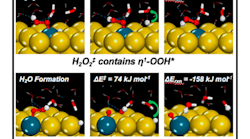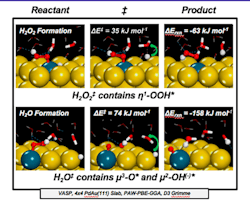Traditional hydrogen peroxide (H2O2) production depends upon a complicated, multi-step process that requires large facilities and involves chemicals derived from fossil fuels, making H2O2 difficult and costly to produce. Now, a team of researchers from the University of Illinois, Urbana-Champaign (UIUC) have improved upon an existing palladium-gold nanoparticle-based catalyst for more-efficient, environmentally friendly H2O2 production.
“This ‘direct synthesis’ method was known to synthesize 80% water and just 20% hydrogen peroxide,” notes David Flaherty, a professor of chemical and biomolecular engineering at UIUC.
So, the researchers began tweaking the arrangement of palladium and gold atoms needed in the nanoparticles to increase selectivity to achieve higher hydrogen peroxide output and less water. They found that a catalyst with a ratio of one palladium to 220 gold atoms generates almost 100% H2O2, which is about the point of diminishing returns.
Figure 1. How the palladium and gold atoms are arranged affects whether water or hydrogen peroxide is formed. Source: Sahithi Gorthy, University of Illinois, Urbana-Champaign.
In addition, the catalyst remains stable over many days of service, continuously achieves high selectivity, and uses clean water as a solvent, which avoids the problematic and corrosive additives often relied on for this chemistry.
“We tested the catalyst for ~100 h on-stream and found minimal deactivation over this period with no loss of selectivity. The catalysts do not appear to sinter or leach to any significant extent during this time…. While it is true that gold is an expensive metal, it is actually less expensive per-mol than Pd or Pt. Additionally, since we do not observe any significant amount of leaching, the catalysts can be recycled at the end of the lifetime to recover the precious metals,” notes Tomas Ricciardulli, a graduate student in chemical and biomolecular engineering at UIUC.
The atoms’ organization within the catalyst also matters, the researchers say. They discovered palladium atoms touching one another favor water formation, while those surrounded by gold favor H2O2 formation. An article in the Journal of the American Chemical Society contains more detail.
The team is pursuing the development of nanoparticle catalysts with new compositions and reactors to enable hybrid chemical-electrochemical methods for this reaction. “Our ultimate goal is to develop feasible technology for distributed production of H2O2, which would open doors for many sustainable alternatives to traditional chemical processes,” believes Flaherty.
“H2O2 can be used in place of a number of other more hazardous or atom-inefficient oxidants like HOCl and Cl2, but is currently too expensive. Industrial H2O2 is almost always sold as a mixture with water and water is expensive to transport, which means that most of what you pay for when you buy H2O2 is actually the transportation and purification (i.e., removal of water). If we could produce and consume H2O2 at a relatively small scale in the same facility, the cost of it would be significantly decreased. However, the current indirect H2O2 synthesis process (anthraquinone auto-oxidation) is only feasible at large scale, which motivates research into direct H2O2 synthesis,” adds Ricciardulli.
The researcher first must address a few challenges before the process can be industrially implemented and profitable. “The most important hurdle is to prevent decomposition of the H2O2 product. There are two possible routes for H2O2 decomposition: disproportionation (2 H2O2 → 2 H2O + O2) and reduction (H2O2 + H2 → 2 H2O). These reactions are somewhat nebulous and not well understood. So far, the research from our group has focused on shutting down the direct water (2 H2 + O2 → 2 H2O) formation pathway, and this study highlights an effective strategy to that end. Now that we have done that, we can turn our attention to better focus on these side reactions.
“In addition to addressing the decomposition reactions, ongoing work within our research group is aimed at increasing the catalyst productivity and decreasing the Au requirement for selective catalysis. To that end, we are investigating the effects of nanoparticle size, nanoparticle morphology, active metal identity, support material and solvent. My first follow-up paper will be published later this year and we hope to have appropriate answers to our research questions within the next few years,” says Ricciardulli.



